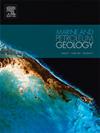Deoxygenation preceding the Carnian Pluvial Episode (Late Triassic) in the Qiangtang Basin (Tibetan Plateau): Implications for organic and inorganic geochemistry and petrography
IF 3.7
2区 地球科学
Q1 GEOSCIENCES, MULTIDISCIPLINARY
引用次数: 0
Abstract
The Carnian Pluvial Episode (CPE; ∼233 Ma) is marked by global warming associated with an intensified hydrological cycle and increased siliciclastic input, coinciding with a widespread crisis in carbonate production. It was further linked to the eruption of the Wrangellia Large Igneous Province (W-LIP), seawater hypoxia, and significant biotic turnover. While some studies have investigated the CPE in Tibet, the environmental and oceanographic processes leading up to this event have received limited attention. In this study, total organic carbon (TOC), biomarker, inorganic geochemistry, and pyrite framboid petrography of samples collected from the Upper Triassic (Carnian) Bagong Formation in the QZ8 well of the Qiangtang Basin (Tibet) were performed to explore the environmental, paleoceanographic, and organic matter controlling processes preceding the CPE. Results exhibit moderate to high enrichments of trace element redox proxies, such as U, Mo, and V, suggesting that the Bagong Formation was deposited under deoxygenation conditions, from severe anoxia to intermittent euxinia prior to the CPE. The presence of pyrite framboids with small mean diameters and narrow distribution ranges further support this interpretation of deficient redox conditions in bottom and pore waters. Additionally, the moderate to strong positive correlations between enrichment factor values of Mo and V and TOC content indicate that the available organic matter was controlled by oxygen-depleted conditions. Enrichment of Cu, Cd, and Zn, along with their Al-normalized ratios that show strong positive correlations with TOC content, reveal high marine primary productivity before the CPE. Meanwhile, the Si/Al, Ti/Al, and Zr/Al ratios showed cyclic patterns around moderate values, suggesting a modest terrigenous sediment supply, consistent with high Sr/Ba and Sr/Al ratios indicating a predominantly saline environment interspersed with enhanced terrestrial/riverine runoff during deposition. Biomarker analysis reveals a substantial contribution of tricyclic and tetracyclic terpanes, with the C19/C23 TT and C20/C23 TT ratios indicating increased terrestrial organic matter input, supported by the presence of Type III kerogen in the Bagong Formation. Prior to the CPE, the climate was warm and humid, leading to accelerated hydrological cycling and freshwater influx of terrestrial organic matter into the Qiangtang Basin. This likely triggered an increase in nutrient supply under severe deoxygenation conditions and a high sedimentation rate, resulting in enhanced organic matter production and preservation regimes while minimizing the carbonate dilution effect.
求助全文
约1分钟内获得全文
求助全文
来源期刊

Marine and Petroleum Geology
地学-地球科学综合
CiteScore
8.80
自引率
14.30%
发文量
475
审稿时长
63 days
期刊介绍:
Marine and Petroleum Geology is the pre-eminent international forum for the exchange of multidisciplinary concepts, interpretations and techniques for all concerned with marine and petroleum geology in industry, government and academia. Rapid bimonthly publication allows early communications of papers or short communications to the geoscience community.
Marine and Petroleum Geology is essential reading for geologists, geophysicists and explorationists in industry, government and academia working in the following areas: marine geology; basin analysis and evaluation; organic geochemistry; reserve/resource estimation; seismic stratigraphy; thermal models of basic evolution; sedimentary geology; continental margins; geophysical interpretation; structural geology/tectonics; formation evaluation techniques; well logging.
 求助内容:
求助内容: 应助结果提醒方式:
应助结果提醒方式:


